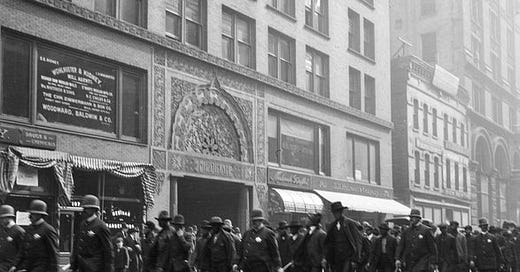The recent contract agreed by UPS and the International Brotherhood of Teamsters, at least as advertised, would end some practices that provide unequal pay for equal work. UPS, like a lot of companies and governments, promotes this type of inequity when it creates a lower-paid class of workers and relies upon both part-time and contract workers who often get lower pay, particularly in the form of employee benefits.
It would be nice if this agreement denotes a step forward that might be followed by other employers and unions. The jury remains out. Among other reasons, senior management and unions doing the bargaining have often represented themselves and not younger or new workers.
You might think that various laws would prevent these injustices. The Equal Pay Act of 1963 requires that men and women in the same workplace be given equal pay for equal work, the Civil Rights Act of 1964 forbids discrimination in compensation because of race, color, religion, sex, or national origin, the Age Discrimination in Employment Act (ADEA) of 1967 makes it unlawful to discriminate in compensation and benefits against any individual age 40 or older, and the Americans with Disabilities Act (ADA) of 1990 protects employees of private firms with impairments or disabilities.
What’s left out in either law or its real-world application? Among others, discrimination remains widespread against the young (who are not protected by the ADEA), part-time and contract workers, and parents who need to spend time with their children.
Traditional pension benefits—those that provide an annual benefit upon retirement—provide a great example of discrimination against the young. As designed, they are of little value to a young person for the first decades on a job, multiply greatly in value if they stay at that one job most of a career, but then almost force older employees to retire if they don’t want to take a substantial cut in total compensation. There’s a set of wonkish reason behind all these strange incentives, including that final annual pension benefits are based upon the highest average salary over a few years, but then decline substantially in value with inflation between when one leaves a job and reaches some minimum age of eligibility.
As 401(k) and similar plans expanded, traditional pensions have been on the wane among private employers, but less so for government employees. Because state and local governments have severely underfunded their plans for decades, they have recently tried to restore some actuarial balance by creating a tiered system, with a much higher level of lifetime contribution and higher retirement age for new workers. As a result, Chad Alderman and Richard Johnson have found that the most teachers newly employed in many of these plans will get negative—that’s right—negative employer-provided pension benefits. That is, the present value of their lifetime employee contributions will be greater than the value of all pension benefits received later.
Part-time and contract workers also lose out in today’s labor marketplace, especially when they receive little or no employee benefits like health insurance. Many employers resort to hiring these workers, and many unions go along. Consider a firm that can no longer survive if it pays all new workers at the going rate for senior workers. The workers not yet hired are not represented in the contract negotiations, where employers are trying to protect profits and senior workers their level of pay for as long as possible.
As for parents wanting to have dinner with their kids, many workers know the cost of not hanging around for late night decisions or being pushed to work overtime—an issue for the UPS drivers. If this were merely a matter of someone working 60 hours getting more pay than someone working 40 hours, there would be no discrimination involved. However, many business still provide large rewards to those who put the job first and only, even when those workers might be less creative and productive per hour than those who put family first.
The design of the nation’s health care systems adds to the discrimination against both the young and lower-income employees. Older workers simply cost more when it comes to health insurance, so even with equal cash pay for equal work, the senior workers get higher compensation. Government tax subsidies for employer-provided insurance reinforce this bias by providing the highest benefits to those with the highest incomes, in the highest tax brackets and with the most expensive health insurance. Without getting further into how government screws workers in the ways it subsidizes health care, this is just one more arena where equal pay is not provided for equal work, no matter what the statutes state.
The consequences extend well beyond the unequal justice involved. School systems find it harder to hire the male teachers who might set an example for the growing number of males disaffected from schooling and society. The protection of senior workers at the expense of younger workers likely has added to the decline of unions over time. The difference in average pay between men and women relates in no small part to the greater efforts women put into childcare and contributes to an inadequate male presence in some homes.
On an economy-wide basis, unequal pay for unequal work makes for a less productive society. It leads some to drop out of the workforce or avoid moving to jobs where they would be more industrious. Difficulties in hiring new quality teachers or retaining older quality teachers due to state pension plan design reduces the quality of education that students receive.
While this summary only touches on many issues, it does raise broad questions for both unions and government policy. First, is a new type of union evolving that will represent both the old and young, the current and not-yet-hired employee? Second, is it time to re-examine the laws regarding equal pay for equal work, with particular attention to ADEA exclusion of the young from protection against age discrimination and the ways that government subsidizes and sometimes provides employee benefits?





